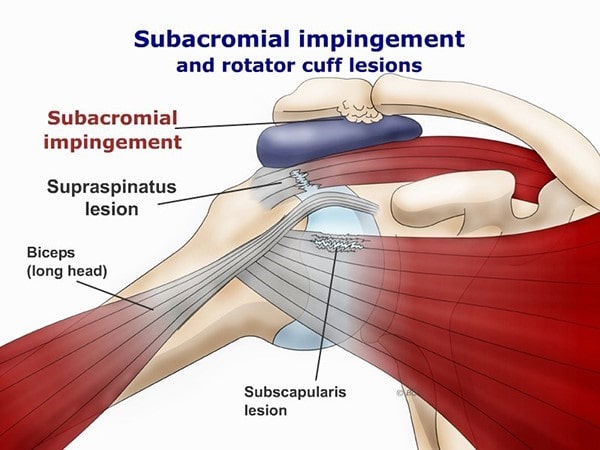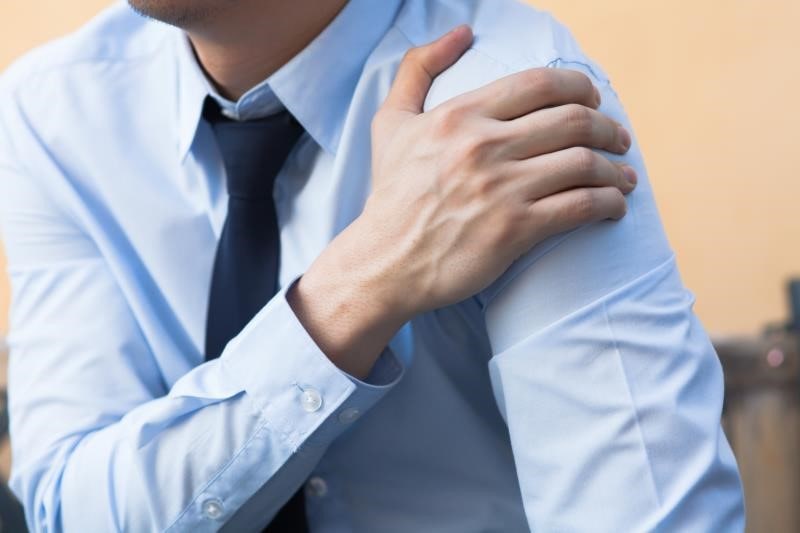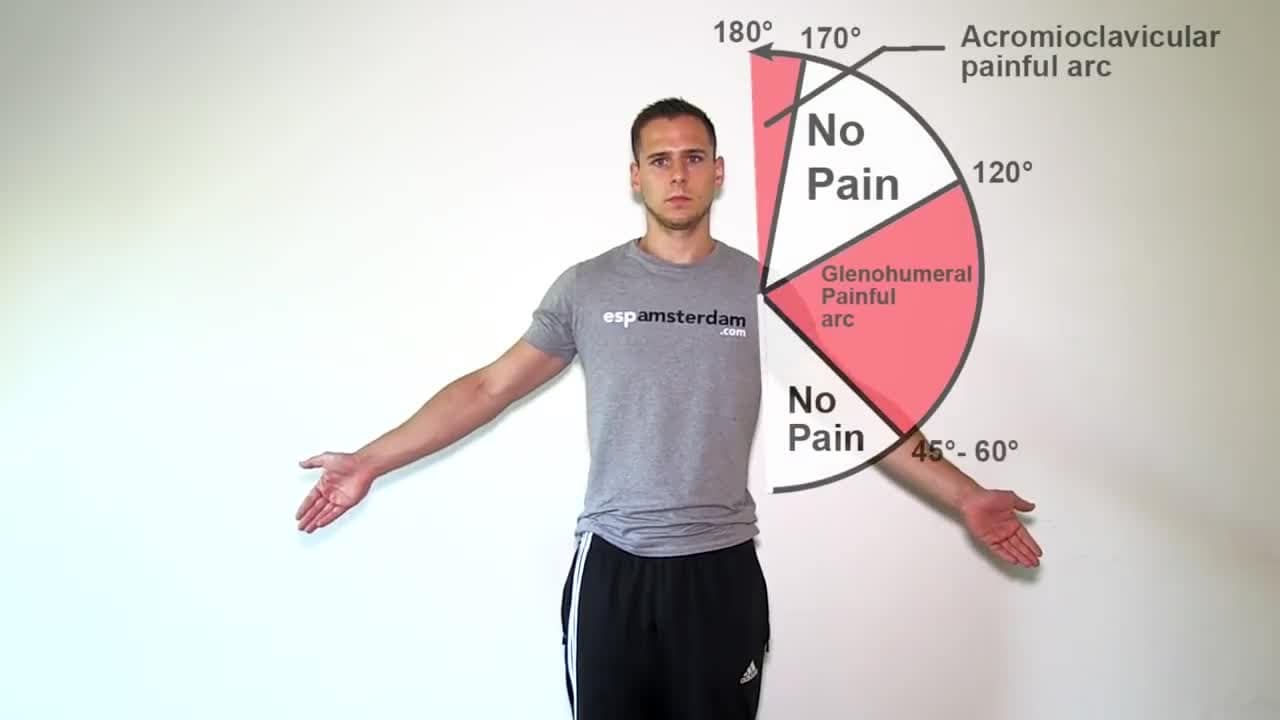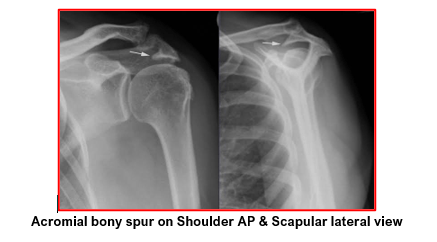Shoulder Subacromial
Impingement & Management
The space between the top of the humeral head (arm bone) and the under-surface of the acromion (the bone at the tip of the shoulder) is called the sub-acromial space. Sub-acromial bursa is a fluid filled sac or balloon, in the sub-acromial space, that covers the rotator cuff and helps in smooth frictionless gliding of the rotator cuff during shoulder movements.
Shoulder Impingement is a condition, caused by pinching of the rotator cuff and the subacromial bursa, in patients who have narrowing of their sub-acromial space. Repeated pinching of the rotator cuff causes inflammation of the tendon (tendinitis) and the overlying sub-acromial bursa (bursitis). These tissues get thickened and further contribute to the narrowing of the sub-acromial space.
The pinching effect happens whilst lifting the shoulder, especially upwards, outwards and forwards during overhead activities. This leads to shoulder pain, weakness and painfully limited shoulder mobility.
The causes of Shoulder Impingement may be:
- Injury to the rotator cuff such as a tear or strain injury can cause the rotator cuff tendon to swell. It can be more prone to catching on the under surface of the acromion.
- A bony spur can develop on the under surface of the front portion of the acromion as part of the normal aging process. This spur can then dig into the superior surface of the rotator cuff and the sub-acromial bursa
- Arthritis of the Acromio-Clavicular (AC) joint may also cause or contribute to impingement due to spurs forming on the under surface of the acromio-clavicular joint.
- Sub-acromial / Sub-coracoid bursal inflammation (bursitis). These bursae are normal fluid filled balloons or sacs, at different locations, within the shoulder. These can get swollen and inflamed. These swollen bursae then get pinched, against the under surface of the acromion or coracoid, leading to shoulder pain and weakness especially with overhead activities.

The symptoms of sub-acromial Impingement are:
- Pain in the shoulder joint - mostly located to the front and outer side of upper arm. Brought on by attempting to use shoulder for overhead activities.
- Difficulty in sleeping over the affected shoulder.
- Disturbed sleep
- Grinding or catching feeling when moving shoulder, especially into overhead position. There may be associated pain and weakness of the affected shoulder.

Shoulder impingement is diagnosed with clinical examination and appropriate investigations.
Medical history is carefully noted, and a thorough clinical examination is performed looking for areas of tenderness, re-creation of pain with certain provocative manoeuvres, checking of muscle strength and assessing shoulder mobility for any limitations.

. X-rays of shoulder joint – help understand bony anatomy, quality of bones around the shoulder, presence of any bony spurs and features suggestive of friction between the prominence of the humerus and the under surface of the acromion.
- MRI Scan – provides information about the quality of muscle and tendon, presence of inflammation of the rotator cuff or sub-acromial /sub-coracoid bursa, presence of any bony spurs pinching the tendon and presence of any tears of the rotator cuff.
- USG Scan – Generally used in those patients who are not able to tolerate a MRI scan. Some doctors use this in OPD settings to diagnose sub-acromial bursitis, rotator cuff tendinitis or tears.
Treatment of Shoulder Impingement can be non-surgical or surgical.
Conservative / Non-Surgical Treatment:
The initial treatment plan, for the majority of the patients with shoulder impingement, is conservative (non-surgical).
This involves combination of rest from work or stressful activities, avoiding repeated overhead activities, taking pain killer & anti-inflammatory medications as required and undergoing appropriate physiotherapy. This helps in controlling pain, reducing tendon inflammation and its pinching. The shoulder function improves gradually over a period of 3 to 4 months.
If shoulder pain continues, despite above treatment plans used for 4 to 6 weeks, then a steroid injection into the subacromial space is helpful.
Once patient’s pain gets settled, physiotherapy is carried on for 2 to 3 months. The aim of shoulder physiotherapy is to strengthen the remainder of the rotator cuff that is not involved and also to teach patients how you to depress the humeral head as the arm is lifted up. This helps in avoiding the pinching phenomenon on the under surface of the acromion and the coraco-acromial ligament.
If the initial steroid injection does not show satisfactory response or after initial pain relief the shoulder pain comes back, then a second steroid injection can be prescribed with a gap for 2 to 3 months from the first injection.
Surgical Treatment – Arthroscopic Subacromial Decompression (ASD)
If a patient fails to respond to non-surgical treatment over 3 to 6 months period or his symptoms worsen during conservative treatment, then arthroscopic surgery is performed.
During this Arthroscopic Subacromial Decompression (ASD) surgery, the interior of the joint and the under-surface of the rotator cuff are thoroughly inspected. Then the sub-acromial space is examined to see the superior (top) surface of the rotator cuff and the sub-acromial bursa. Any thickened soft tissues or downwards projecting bony spurs are identified. Inflamed subacromial bursa is removed initially with a radiofrequency device. This is called subacromial bursectomy.
Then the thickened soft tissue (coracoclavicular ligament) or the acromial bony spurs noted to be pinching the rotator cuff tendon are cleared and trimmed with specialised instruments. This is called sub-acromial decompression.

If inflammation and fraying of the rotator cuff tendon is noted, then the tendon is debrided to clear any frayed tissue. This prevents catching / rubbing of the rotator cuff tendon against the acromion.
If any tendon tears are seen, then they are thoroughly assessed. They are either debrided or repaired as per their severity.
The aim of sub-acromial decompression surgery is to create more space in the sub-acromial region. This relieves pain, allows frictionless movements of the rotator cuff, improves shoulder mobility and its overall function.
Book An Appointment
Private Clinics : Locations & Directions
London Joints Clinic (Pune)
Address
Office S 5, 2nd Floor, North Block, Sacred World Mall,
Opp Sacred Heart Township, Near Jagtap Chowk,
Wanawadi, Pune 411040
Monday, Wednesday & Friday 7 PM to 9 PM
Sunday 11 AM to 1 PM
Appointments
London Joints Clinic ( PCMC )
Address
C/O Dr Nitin’s Physio Clinic,
Opp. Brahma Hotel,
Near Akurdi Post Office,
Vivek Nagar,
Akurdi,
Pune 411035
Saturdays only 4.30 PM to 7.30 PM
Appointments
Hospitals OPDs : Locations & Directions
Manipal Hospital

Address
Manipal Hospital, Opp D Mart, Baner-Mhalunge Road, Baner, Pune 411 045
Monday to Saturday 11 AM to 4 PM
Appointments
Contact us
Dr Anand Jadhav has a centralised appointment system for all locations across various hospitals and clinics in Pune & PCMC areas
Appointment Bookings & Requests can be made by any method :

